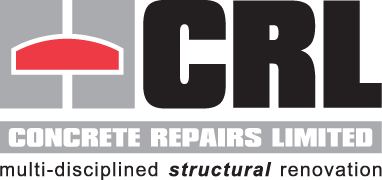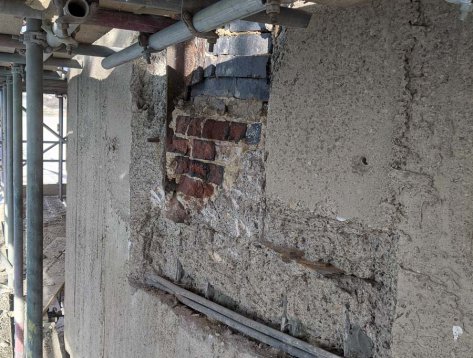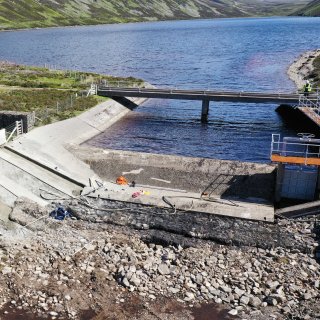Major repairs to mine shaft with significant CO2e savings for our client ...
Boulby Mine, located in the North York Moors National Park is the world’s first and only Polyhalite mine. Polyhalite is natural multi-nutrient fertiliser and a source of potassium, calcium, magnesium and sulphur.
The main shaft building is a cast in situ concrete structure with primary and secondary steel reinforcement. It houses a steel sheave wheel and supporting structure that provides access to the UK’s deepest mine to a depth of 1200m. The external elevation of the structure extends 45m above ground level and is 12.5m in diameter to the outer face with a 300mm thick concrete wall.
The shaft is approximately 50 years old and was in need of structural refurbishment. Significant areas of repair were required internally and externally on the shaft walls. There were areas of cracking and spalling as a result of corrosion to the reinforcing bars. This damage was likely caused by chlorides in the coastal air and in the mined materials. Internally, high humidity levels further accelerated corrosion.
CRL were appointed as Principal Contractor and structural refurbishment specialist with works commencing on site in October 2020. From the client’s perspective, it was key to keep the shaft operational during the internal works.
Externally, the works involved the design and erection of a 45m high, fully encapsulated external scaffold around the perimeter of the shaft. Significant hydro-demolition works were carried out to remove 31m3 of defective concrete. Structural steelwork was then installed with the existing steelwork cleaned and fully prepared to remove all rust and laitance.
More than 1500 sacrificial anodes were then incorporated within the concrete repairs to slow down any future corrosion of the reinforcement, thus enhancing the service life of the structure. The concrete repair mortar was then applied using a mixture of hand applied and dry spray techniques. The whole structure was thoroughly cleaned to remove all surface contaminants prior to two layers of anti-carbonation coatings being applied to help protect from the concrete from any future corrosion issues.
With over 57m3 of concrete broken out and replaced, several tonnes of structural steelwork installation, over 2700 anodes installed, and over 3500m2 of anti-carbonation coatings applied, whilst also strengthening key elements using Carbon Fibre, this project was a significant refurbishment exercise utilising numerous structural rehabilitation techniques. The project was successfully and safely (circa 30,000 man hours worked accident free) delivered on time and to an excellent standard – all during the height of the pandemic.
The scope of works included;
-
-
- erection of scaffolding,
- extensive hydro-demolition works,
- concrete repairs,
- installation of galvanic/sacrificial anodes, and
- application of hand applied & sprayed repair materials.
-
Environmental Benefits
CRL’s restoration approach offered environmental benefits including significant emissions savings. We measure emissions from materials, waste and employee commuting.
When comparing the material requirements and associated embodied carbon emissions of both options (replacement and restoration), there are substantial savings in CRL’s restoration option. We used the UK Government’s conversion factors (2021 – revised January 2022) to calculate the following embodied carbon emissions. We compared the concrete and steel materials requirements to illustrate these savings.
CRL’s restoration approach offered estimated savings of 91% in the volume of concrete required, and 96.5% in the volume of steel required. The total emissions savings from emissions was an estimated 93.8%.

Through our waste management suppliers Reconomy and Wilf Noble Recycling Ltd, 100% of site waste was diverted from landfill, being either recovered or recycled. Reconomy provided us with a waste management carbon emissions report for the project. Using the same waste volume/emissions ratio from our Reconomy reports, we estimate the waste management emissions of the replacement option would have been 93.7% higher.
For both internal and external phases, 66.67% of our full-time employees were from the North-East, helping to reduce emissions from commuting. Those that commuted from further afield would have stayed in accommodation to further reduce travel emissions. We estimate a saving of 85% in carbon emissions.
In summary, CRL’s restoration approach offered an estimated 90.7% carbon emission saving versus the replacement alternative just from the materials, waste management and employee commuting alone. While our calculations have not accounted for all emissions from the project, we have accounted for the main sources. Our total figure highlights the significant carbon savings of CRL’s operations and alternative restoration solution.

Social Value
Our social value delivery focussed on two key areas. Bringing in new employees from the local region and carbon emissions savings made through our sustainable approach to restoring the man riding shaft. We used the National TOMs Framework to give a financial social value delivery.
Employing locally is important for CRL to support local economies and communities. We have a strong workforce based in the North-East. In addition to many existing CRL employees from the region, we were able to recruit 6 direct employees based in the North-East, including Darlington, Middlesborough, Newcastle and Sunderland. Total employment time equated to 3 FTE employees. Using the National TOMs measurement NT1, this gave a total social value delivery of £94,383.
Sustainability is at the core of our business model. By repairing and restoring assets, we offer a more sustainable option that the traditional demolish and rebuild approach. This cuts out significant levels of carbon emissions in all areas of the project. The estimated 90.7% saving in carbon from materials, waste and employee commuting is an example of this. Using the National TOMs NT31 measurement, this gives a social value delivery of £43,617.30.
The total social value delivery of this project was £138,000.30.

The project is an example of the benefits of repair/refurbishment over replacement. The cost savings to the Client, the ability to maintain operations and the environmental benefits make this an excellent example of a sustainable construction project.

"With close collaboration between ourselves as principal contractor, the client and our sub-contractors, the project has run smoothly without any major issues."
Matt Robinson | Regional Manager | CRL




















